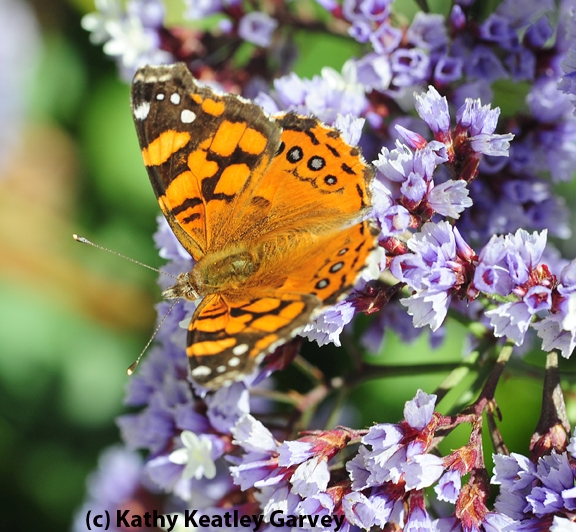- Author: Kathy Keatley Garvey
There's nothing like seeing an admiral at a marina.
That would be the Red Admiral butterfly, Vanessa atalanta, at the Berkeley marina.
It's often very common in the urban Bay Area, says butterfly expert Art Shapiro, professor of evolution and ecology at the University of California, Davis. The Red Admirals often share sites with West Coast Ladies.
"Both breed on the weed Parietaria judaica (Pellitory) there."
We also saw a West Coast Lady, Vanessa annabella, fluttering around the Red Admiral last Saturday.
But it's the other butterflies that Shapiro is concerned about. "At this time of the year, one used to see Great Coppers (Lycaena xanthoides) up the yin-yang on the 'waste ground' across the marina parking lot, between it and the freeway. Since they made it part of Eastshore Park, it seems to be gone. Typical!"
Other "marina fauna" from back when, he says, included Anise Swallowtails and Large Marbles. "The latter seems to be gone too; it's extinct regionally but there is one population I know of near Concord."
A renowned lepidopterist, Shapiro monitors the butterfly population in Central California and posts information on his website, Art's Butterfly World.
He's the author of the book, Field Guide to Butterflies of the San Francisco Bay and Sacramento Valley Regions, illustrated by Tim Manolis. "The California Tortoiseshell, West Coast Lady, Red Admiral, and Golden Oak Hairstreak are just a few of the many butterfly species found in the floristically rich San Francisco Bay and Sacramento Valley regions," Shapiro writes. He covers and identifies more than 130 species in the book.


- Author: Kathy Keatley Garvey
Beauty isn't skin deep. It's wing deep.
The Anise Swallowtail butterfly dazzles you with its yellow stripes and blue dots. If it were a painting, it would be a Michelangelo. If it were music, it would be Vivaldi's "Spring." If it were a car, it would be a sleek Lamborghini.
But there it was, a bit of beauty in the otherwise-drab Berkeley marina parking lot. So, I did what all insect lovers do--I photographed it. (See photo below)
Arthur Shapiro, professor of evolution and ecology at UC Davis--and as brilliant as the butterflies he studies--knew exactly what it was. After all, he published his first paper on butterflies in 1962 at age 16.
“Papilio zelicaon, female,” he said.
Just like that.
Shapiro is the author of the newly published “Field Guide to Butterflies of the San Francisco Bay Area and Sacramento Valley Regions,” illustrated by Tim Manolis. In the book, published by the University of California Press, Shapiro discusses and identifies more than 130 butterfly species.
The book is as awesome as his Web site, his own butterfly world. His Web site spans more than three decades of research and observations.
Glad you asked.
When you were in school, you may have reared it in your classroom. It's easy to rear, Shapiro said, but don't provoke it. The caterpillar has “an eversible scent gland (the osmeterium) behind the head. It's yellow or orange and shaped like the letter 'Y' and if the beast is provoked, it releases a mist of butyric acid--rancid butter smell--which will hang in the air many minutes.”
The caterpillar can be a pest in cultivated citrus, but a minor pest.
The Anise Swallowtail is found in most of the western states. Its main hosts are members of the carrot family, Apiaceae. It also feeds on the rue family, Rutacease.
The carrot family includes anise, fennel, dill, celery, parsley, parsnips (I hate parsnips—I'm glad something likes them!) and Queen Anne's lace. The Anise Swallowtail even eats the extremely poisonous water hemlock (Cicuta) and poison hemlock (Conium) “without ill effects,” said Shapiro. “When Socrates drinks, everybody drinks,” he quipped.
This little ol' butterfly is also a famous “hilltopper,” Shapiro said. “In rugged topography, males and virgin females assemble on rocky unforested hilltops to mate--it's a butterfly 'singles bar.' The females do not return once mated, but the males come back day after day looking for action."
If you want to know more about butterflies, then Art Shapiro's “Field Guide” is a must-have for your collection.
And if you find an Anise Swallowtail in the Berkeley marina parking lot, it's mine.





